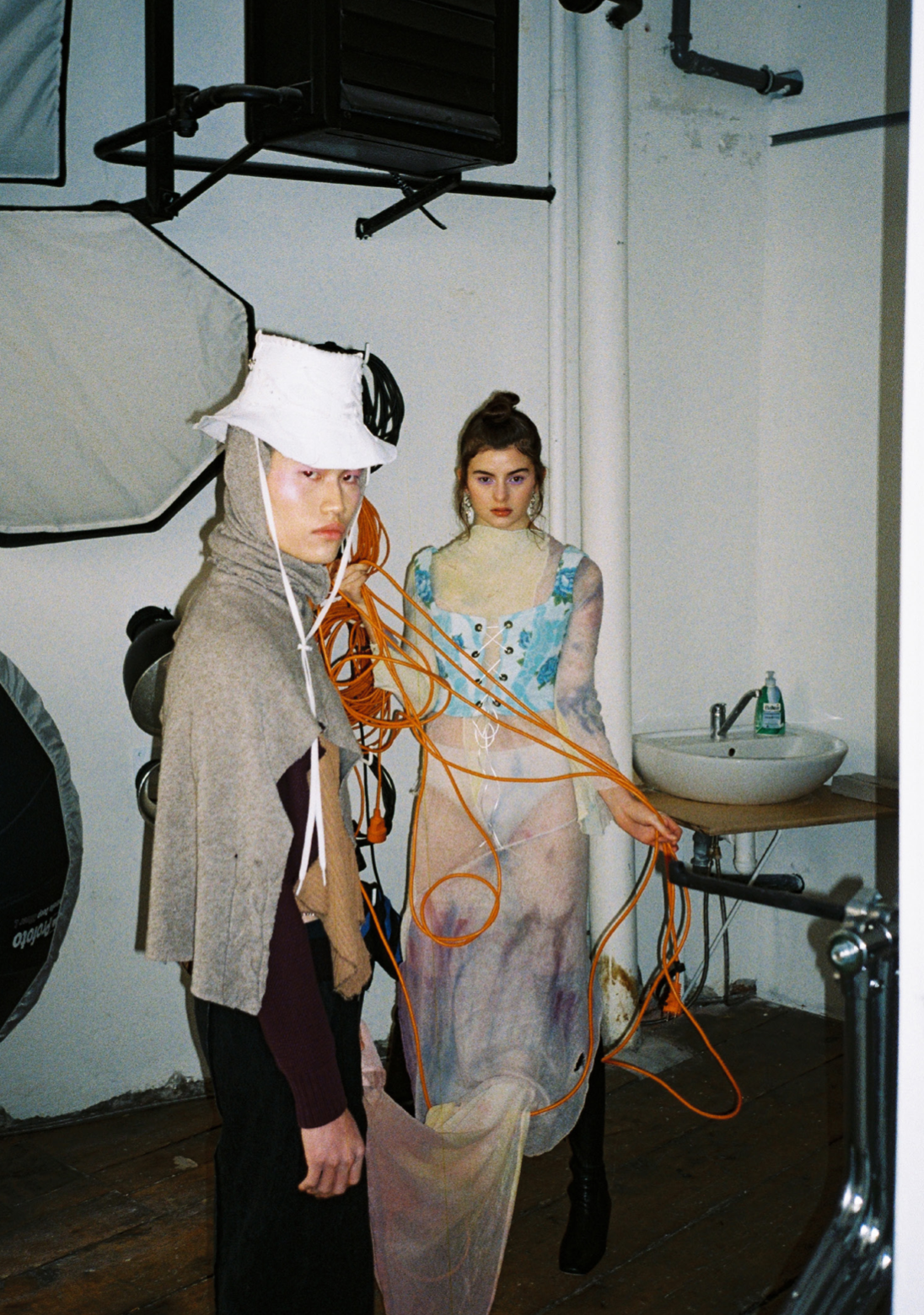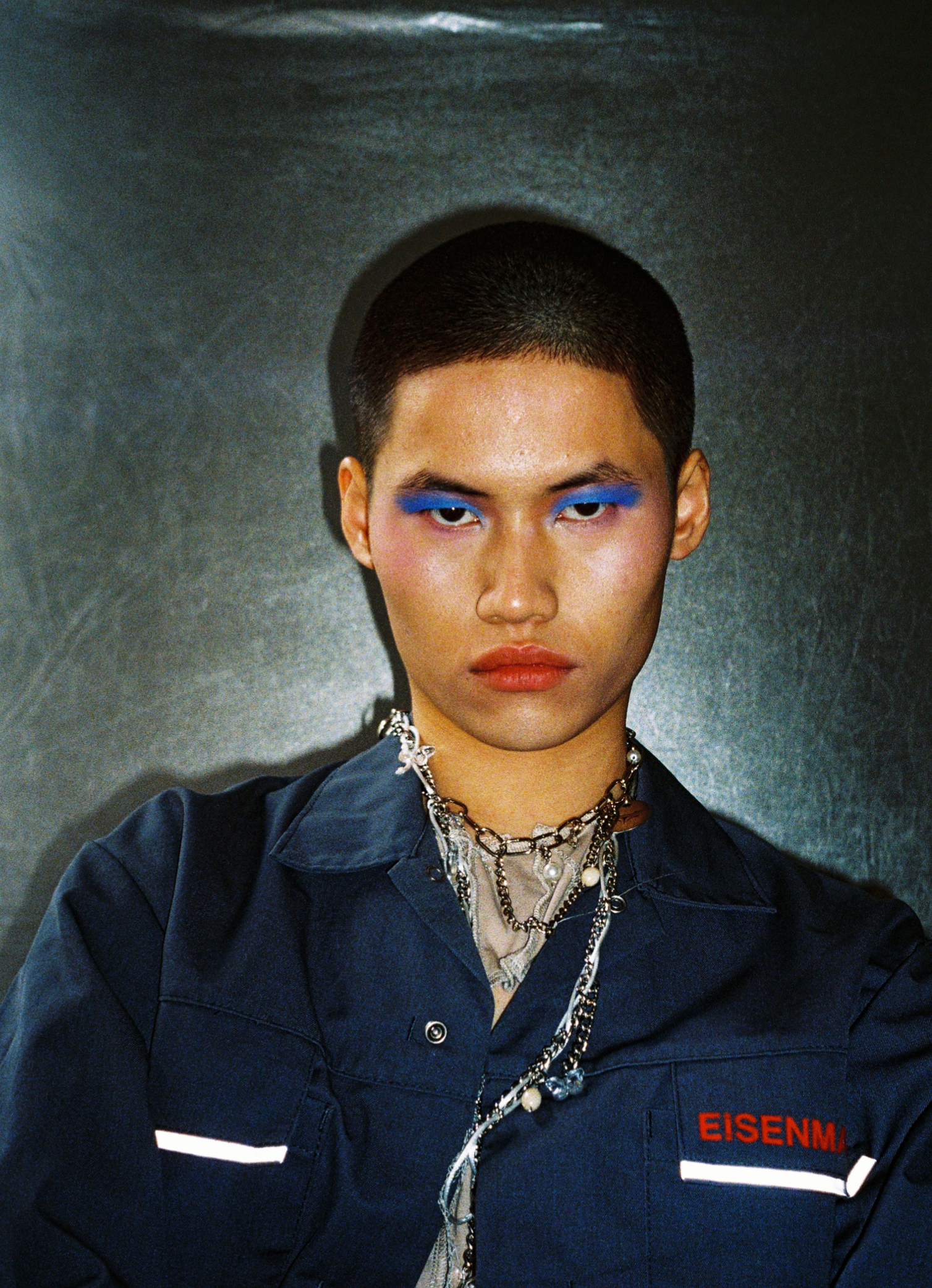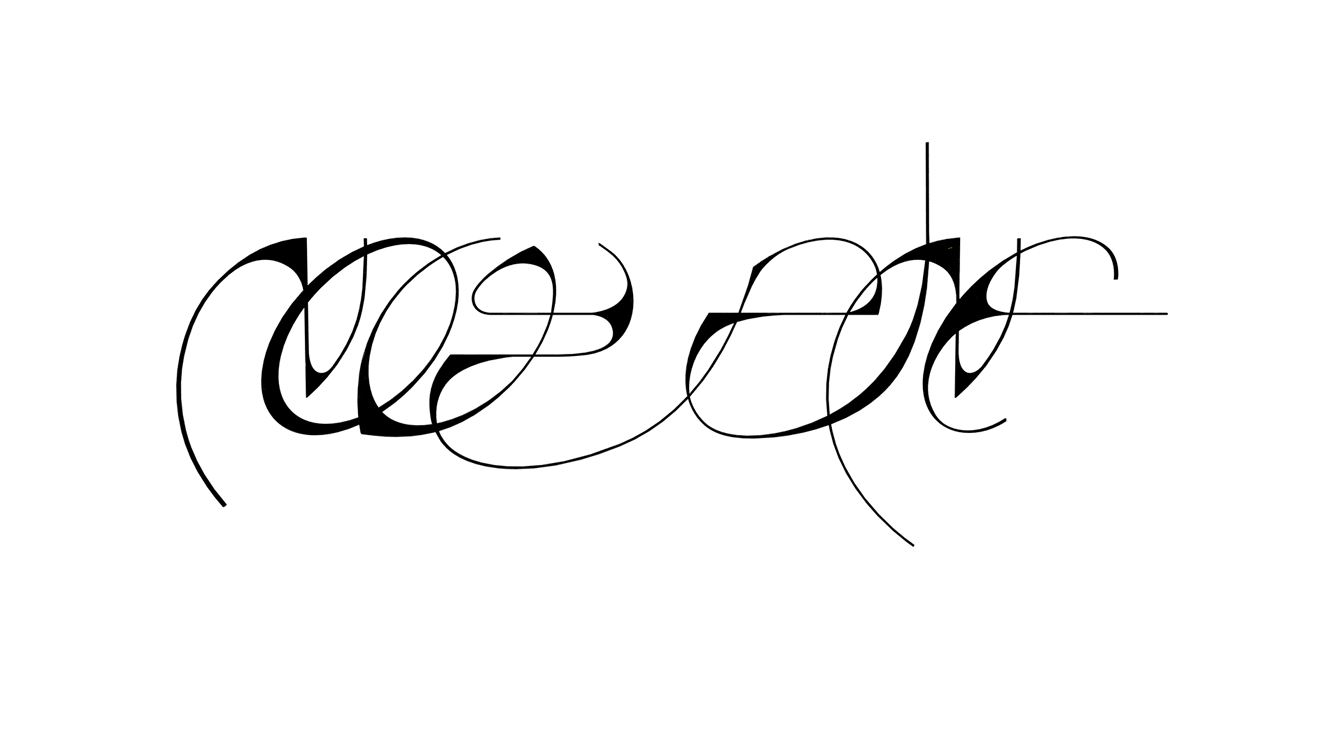UPCYCLED REVOLUTION
Transformation, attitude, and paradox: Vintage and upcycled fashion, in the context of sustainability
Text by Veronika Soukupová
Clothing stands curved under an onslaught, a rake with goods at popular prices, and the ubiquitous haze of disinfection - these are the memories that millennials associate with a visit to a second-hand store. Second-hand shopping was, a couple of years ago, deemed as just an extreme alternative to buying a new piece of clothing for your wardrobe. The tables have now completely turned, thanks to the younger generation. The stigmatised second-hand shopping, and DIY ways of repairing your clothes at home, have now changed into more sophisticated concepts of buying vintage and upcycling, pushing the boundaries of fashion. These concepts embody a distinctive attitude and lifestyle, evoking authenticity and freedom. As they become a trend, they pose new challenges to sustainable thinking. What forms does this fashion (and social) revolution take on in Czechia?

photography TAJA SPASSKOVA
styling KRISTÝNA COUFALOVÁ
muah KRISTÝNA ZBOŘILOVÁ
TANYA ZVOLSKÁ and FILIP SLUKA
styling KRISTÝNA COUFALOVÁ
muah KRISTÝNA ZBOŘILOVÁ
TANYA ZVOLSKÁ and FILIP SLUKA
At the beginning of the millennium, clothing and dressing up was undoubtedly subjected to the supply of fashion chains. As the term, “fast fashion", often associated with fashion chains, suggests these brands always react very topically and flexibly to the desires of customers, and to the latest catwalk trends. They offer almost identical variants to those of fashion designers, cheaply, but at the cost of low quality. The fashion industry is driven by frequent market shifts and the transience of trends. Second-hand shopping therefore, of course, holds negative connotations amongst this competition, and has earned the mark of second place. “It’s not that long ago that second hand-shopping was something you didn’t brag about”, says David Homola, one of the founders of the online second-hand shop 1981.cz. In a second-hand shop, to be able to find a piece that would resemble one from an H&M collection would mean long hours of seeking, with one rule in mind, that is, first come first serve. The low price tag, which is one of the main motivations as to why one would visit such a shop, would allow the customer to find, perhaps even, a timeless piece, of which the real value will invariably be revealed much later on.

photography TAJA SPASSKOVA
styling KRISTÝNA COUFALOVÁ
muah KRISTÝNA ZBOŘILOVÁ
TANYA ZVOLSKÁ and FILIP SLUKA
styling KRISTÝNA COUFALOVÁ
muah KRISTÝNA ZBOŘILOVÁ
TANYA ZVOLSKÁ and FILIP SLUKA
The rehabilitation of second-hand fashion was definitely accelerated through the growing awareness of the fatal consequences of the fashion industry, and the unethical working environment in factories.The revolt on the part of customers was further fuelled by the collapse of a building in Bangladesh, housing a textile factory, which was responsible for sewing clothes for multinational corporations. Despite the cracks in the walls being obvious, the workers were forced to keep working - and more than a thousand of them fell victim to the inevitable catastrophe. The Fashion Revolution platform has, since the tragedy, made a significant commitment to educating the general public, and has taken the initiative in spreading awareness. Consumers were particularly influenced by the hashtag #WhoMadeMyClothes, which has created a massive debate on social networks around the world, every year, including Czechia. Czechia is no exception, and significantly contributes to the enormous production of waste as well. According to the Institute of Circular Economics, up to 200,000 tons of clothing end up in domestic landfills every year, and only 3% of them find further use.
Mainstream culture is now heading in the direction of finding alternatives - of minimalism and sustainability. Among the younger generation, the position of second-hand fashion has started to dynamically shift and radically change. According to the survey of an American, on-line second hand shop, ThredUp, conducted by GlobalData, the community that shops second-hand is constantly growing. “The coming generation of younger people does not have an ingrained sense of scarcity from the previous regime, and unlike our parents, they do not feel the need to compensate for it, whilst disregarding the planet. Before one buys something new, they will first see if the item is not being sold by someone who no longer needs it”, says designer and stylist Kristýna Coufalová, who emphasises that the way to save the planet is to learn how to share, to support local production, and to upcycle already existing pieces.
The transformation of textile waste, with the aim of turning discarded material into wearable clothing (ie upcycling), is another step towards sustainability. Martina Feitova is one of the first designers in Czechia to devote herself to upcycling, and has been creating pieces since 2015, under the brand Recycle Store. Martina describes her work saying that, “Making upcycled clothing is a constant game. When I think of a new prototype, it isn’t certain that I’ll be able to find the required material in a second hand-shop straight away - and in good condition. This is why it’s important to remind consumers of the uniqueness of this concept”. Nowadays, fashion designers are moving towards upcycling more and more often. Some go beyond textiles and use old shoes, especially sneakers, to create pieces. This became the starting point of the collections by Tran Ngoc Yen or Kristýna Hrabánková.
The possibilities of upcycling are endless. The same principle is being increasingly (re)implemented in other practises of art and crafts. One example is architecture, where the original interiors, or whole buildings, are reimagined and transformed. This concept, referred to as repurposed buildings or refurbishment, isn’t strange to the Prague-based project Proctor 39. The four-member team, passionate about old buildings, revived the dilapidated Žižkov house, which once housed a printing factory, a few years ago. The original plan, to use one floor for meetings, eventually resulted in a multicultural five-storey space with a café, gallery, studios, motion and graphic studios, shops, and a place for workshops or cultural events: “No major building modifications were required, as we wanted to preserve the original character of the building. Nevertheless, it was still a major task. The revitalisation of the house was one big upcycling project. We tried to use and remake as much of the already available material as possible, and at the same time, buy as little new materials as possible”, says one of the founders, Kamila Martinková. Upcycling is accessible to anyone, and in addition, DIY holds a strong tradition in our culture. One just needs to look back in time, or peek into the homes of our grandmas, for whom the remaking and refashioning of things was (and still is) a natural part of life.

photography TAJA SPASSKOVA
styling KRISTÝNA COUFALOVÁ
muah KRISTÝNA ZBOŘILOVÁ
TANYA ZVOLSKÁ and FILIP SLUKA
styling KRISTÝNA COUFALOVÁ
muah KRISTÝNA ZBOŘILOVÁ
TANYA ZVOLSKÁ and FILIP SLUKA
The return of this practise demonstrates various social shifts as well, according to Linda Strakova, London’s CSM student of Innovation Management: “In the past, upcycling came about due to the scarcity of materials, financial recession, and in the 90s as a way of disrupting society’s visual standards”. From a sociological point of view, it is not surprising that upcycling is back in fashion in times of surplus, which is, however, "threatened" by the climate and pandemic crises. Fashion, to some extent, reflects social and cultural conditions of its time.
Consumer behaviour has indeed changed from the ground up in recent years. As the mentioned findings of GlobalData suggest, having a cool piece from a thrift shop serves as a reason, for the younger generation, to be proud. Shopping in fashion chains has, on the other hand, acquired a stigma similar to the consumption of products from fast food chains. However, the fashion enthusiasts of the youngest generation seldom visit second-hand shops, and instead, they make use of their own selective on-line stores. With the help of social media, they are building, and maintaining, a community of people who support them through purchases and sharing of posts. They are united by a comprehensive concept that fits exactly into the current aesthetic. In addition, one doesn’t shy away from spending money on curated pieces - on the contrary, there is a growing willingness to invest amounts of money that often exceed the price of new goods. “Many of our customers don’t have a problem with spending thousands of Czech crowns for a quality piece, which will last them a number of years. The perception of buying second-hand as a cheaper alternative to buying clothes is gone”, says David, from 1981.cz.


photography TAJA SPASSKOVA
styling KRISTÝNA COUFALOVÁ
muah KRISTÝNA ZBOŘILOVÁ
TANYA ZVOLSKÁ and FILIP SLUKA
styling KRISTÝNA COUFALOVÁ
muah KRISTÝNA ZBOŘILOVÁ
TANYA ZVOLSKÁ and FILIP SLUKA
Vintage and upcycling is therefore becoming, not just a trend, but also a status symbol, a carrier of meanings and values. The discourse has changed and it no longer refers to the term “second hand”, replacing it instead with “vintage” regardless of the technical definitions. “Vintage” means freedom and it doesn’t adhere to the commands of fashion corporations. Despite drawing on the past, it doesn’t desire a nostalgic return, but rather, a novelty.
Sustainability remains one of the motivations for buying vintage or upcycled clothing, but a stronger motivation could be the specific aesthetics set by global trends, as described by Linda Straková, and fashion publicist, Veronika Ruppert. Particularly the technique of patchwork has returned, which is based on the principle of combining pieces of fabrics of various colours, patterns, and materials into a single garment. It brings with it memories of the beginning of the millennium, but it is also closely relates to societal changes brought about by climate change and the pandemic. Throughout quarantine, social media was filled with DIY instructions on how to create fashionable, and sustainable, pieces by using what we have readily available around us - unworn clothes.
Through the example of patchwork, we can also demonstrate the paradoxes of this (seemingly sustainable) sustainability trend. Veronika Ruppert points out that due to the combination of various materials, clothes often lose their silhouette when washed, and very quickly turn to being textile waste. In addition, the possibilities to recycle the garment further are, due to the same reason, also limited. “The concept of sustainability sometimes fades away. Some designers and brands don’t care so much for being sustainable, as they do for being aesthetically trendy. In this way, the original thought becomes flattened or completely insubstantial. Martina Feitová speaks about a similar instance: “I have a feeling that creating, so-called, sustainable fashion has become another trend, and it’s hard to tell whether the motif behind it is ecological, or a part of the business strategy.”
photography TAJA SPASSKOVA
styling KRISTÝNA COUFALOVÁ
muah KRISTÝNA ZBOŘILOVÁ
TANYA ZVOLSKÁ and FILIP SLUKA
styling KRISTÝNA COUFALOVÁ
muah KRISTÝNA ZBOŘILOVÁ
TANYA ZVOLSKÁ and FILIP SLUKA
Questions regarding recycling therefore point to a complex topic and landscape to navigate not only for consumers, but for the creators themselves as well. Clothing designer Kristýna Hrabánkova, whose practise balances both wearable clothing and its conceptual form, is also aware of the limits that the ecological approach to creating has. “I combine the lightness of the thought with a functional solution that responds to the present time”, says Kristýna, whilst pointing out that it’s, “important to produce the product in a way so that it’s not only ecological, but also aesthetically pleasing. If no one will want to wear it, then it all loses its purpose”. The line is thin. If the garment doesn’t hold visual qualities, it won’t be able to generate profit, and the cycle of sustainability will be disrupted. The producer won’t be able to pay their workers and to create a fair, and ethical, working environment. As well as that, the scenario in which the garment will also probably end up in landfill is already familiar. Sustainability is therefore very complex, and a very complicated topic, and it’s necessary to reflect on it in every aspect of fashion production.
Naturally, multinational companies are also responding to the rising interest in the environment. However, as Linda Straková points out, they are not yet able to plan the entire production with the help of upcycling. They borrow, or more accurately, misappropriate, just the values, and visuality, of this technique to create products from new materials in full accordance with their one-way operation model - from production to waste. This is a marketing move referred to as “greenwashing”, where the company falsely presents itself to the public as being environmentally responsible. The informed customer should therefore always check, in addition to the origin of the goods and the circumstances of production, whether the brand is merely misinforming in this regard. According to Linda, the ideal approach seems to be the, so-called, critical buyer approach, where shopping becomes a conscious activity. With every purchase, perhaps even through small steps, we pave the way we want to take in the future. Be the change you want to see in the world.
The direction that vintage and upcycled fashion is taking, in the hands of the young generation, is therefore twofold. It comes with contradictions, but it also generates a social transformation, and a significant milestone, in the development of fashion. The popularity of both of these concepts is accompanied by the potential to slow down unsustainable fast fashion processes. “If people buy vintage fashion, not only due to it being a trend, but with the aim of being more sustainable, they can begin to decide which direction the fashion industry will take”, says Martina. Social pressure, demanding the transparency and responsibility of companies for their own production, is massive. “Big brands are being increasingly cornered to react to the demand for sustainability, and they are beginning to use different materials and find ways to upcycle, even though this might mean a more costly journey”, says Veronica Ruppert, who has been delving into this topic for a long time. After all, a positive change was predicted by all respondents. "The future of fashion is circular”, says Kristýna Coufalová. At the end of the day, however, the most sustainable garment is one that is not made at all.
See the Czech version of this article together with visual artworks in NOVY ZINE, issue 1.
